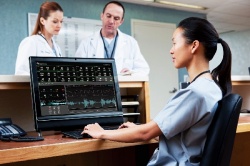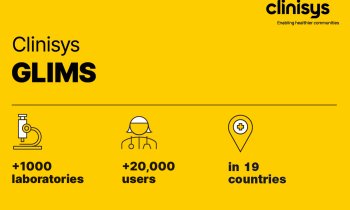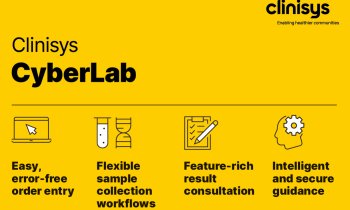Patient Safety
Raising small patients’ safety yet reducing staff mileages
The safety of little children at the University Children’s Hospital Basel (UKBB) has been assured since February by the installation of Patient SafetyNet, an advanced remote monitoring and clinician notification system manufactured by the California-based company Masimo.

Basel’s multi-department paediatric facility – the first of its kind in Central Europe – has the system linked to every one of its 80 general ward beds for in-patient care. Result: Patient SafetyNet has not only augmented the children’s safety but also saved nurses from lengthy, unnecessary footwork, thus contributing towards improved workflow.
Prior to this new installation, UKBB Nurse Manager Ruth Spalinger recalls: ‘We had moved departments and there were stand-alone monitoring devices in the patient rooms. There were no alarms in the corridors or in the wards to alert nurses. Therefore, staff had to carry phones along, which proved to be very distracting, especially due to the high occurrence of false alarms. Nurses had to run back and forth continuously to check on alarms, putting extreme stress on staff and also hindering important bedside conversations with patients and their parents.’
When an alarm went off, she added, a nurse arriving in the ward where it had been activated could not quickly identify which patient’s bed was involved, and the measurements were not archived, she told European Hospital: ‘This situation had to change – and we designed a strategy for improvement.’
The one and only manufacturer
An extensive evaluation process resulted in the hospital’s standardisation to Masimo SET pulse oximetry. ‘Masimo was the only manufacturer willing to provide equipment and services according to the tall requirements we had defined,’ Ruth Spalinger points out. ‘This included handling artefacts – meaning false alarms produced by patient movement. Masimo offered us a system that measures through the artefacts and results in dramatically fewer false alarms.’
Today, UKBB’s new, non-invasive monitoring devices provide continuous measurements of patient functions, such as oxygen saturation and pulse rate, and, optionally, breathing rate – a value only measured by nurses in the intensive care unit and during anaesthesia.
Based on the data set produced by the device, a “Halo” index is generated – meaning an indicator developed by Masimo that facilitates the assessment of multiple physiological parameters to quantify changes in patient status. A readout ranging from 1 to 100, with a higher number indicating a higher risk, gives clinicians a quick assessment of each patient throughout the ward; patient movements do not impair results, thus clearly eliminating false alarms. All data are stored for 30 days, before they are overwritten. Important sequences can always be stored via PDF for means of patient documentation.
When values no longer match the individual HALO norm, an automatic alert is transmitted wirelessly direct to clinicians. Sensibly, those alarms are generated even before some alarm limits are reached, so that patients can be checked far sooner. The staff is also aided by readouts enabling them to judge the level of urgency in each situation.
A tangible change for the best
‘Installation of the Masimo system has resulted in significant improvements regarding patient safety and it has greatly reduced the staff workload, allowing nurses to concentrate on their task of caring for patients instead of doing miles on foot,’ the Nurse Manager confirms. ‘We’ve observed that the system is particularly beneficial for our most vulnerable patients, who potentially suffer from respiratory depression.’ The staff, she adds, is ‘extremely satisfied with the system’ including physicians who are distracted no longer by audio signals during their ward rounds.
‘In many hospitals, decision makers think that implementing remote monitoring in general wards is highly complex, resource intensive and expensive,’ says Paul Jansen, Masimo’s Vice President of Marketing and Development. ‘The unique implementation at UKBB has demonstrated the feasibility of Patient SafetyNet which, among other aspects, allows hospitals to utilise remote monitoring with an unchanged number of staff.’ This hospital is leading the way, he adds, and many other care providers will soon follow suit.
Ruth Spalinger believes that ‘remote monitoring based on systems such as Patient SafetyNet could help reduce the number of patients admitted to ICUs’. ‘Across healthcare systems, large numbers of patients are sent to intensive care because they need to be monitored. In general wards, just like the situation was at UKBB, suitable monitoring is not available. This could be changed by the widespread implementation of the Masimo system, reducing risks for patients and alsosignificantly cutting costs.’
Future integrations
Speaking of new developments: ‘We can now connect Patient SafetyNet with hospital information systems (HIS),’ he affirms. ‘This allows us to feed patient demographics from the HIS into our system; and, with automatic communication of values to the HIS, manual charting by nurses might may become a thing of the past.’
Typically, pumps that deliver medication are not connected to any alert communication system – ’now, these pumps can also be connected to Patient SafetyNet, with an icon on the application screen presenting alarms. There’s increased interest for such a solution in the market,’ Paul Jansen points out. Integration will be realised through Masimo’s Root patient monitoring and connectivity platform.
In conclusion: As our meeting in Basel draws to a close, Paul Jansen declares: ‘Far too many preventable deaths are still happening in hospitals today. Masimo’s solution gives hospitals exactly what they have been asking for to improve patient safety – a clinically proven and costeffective system that doesn’t require additional nursing resources
21.11.2014











